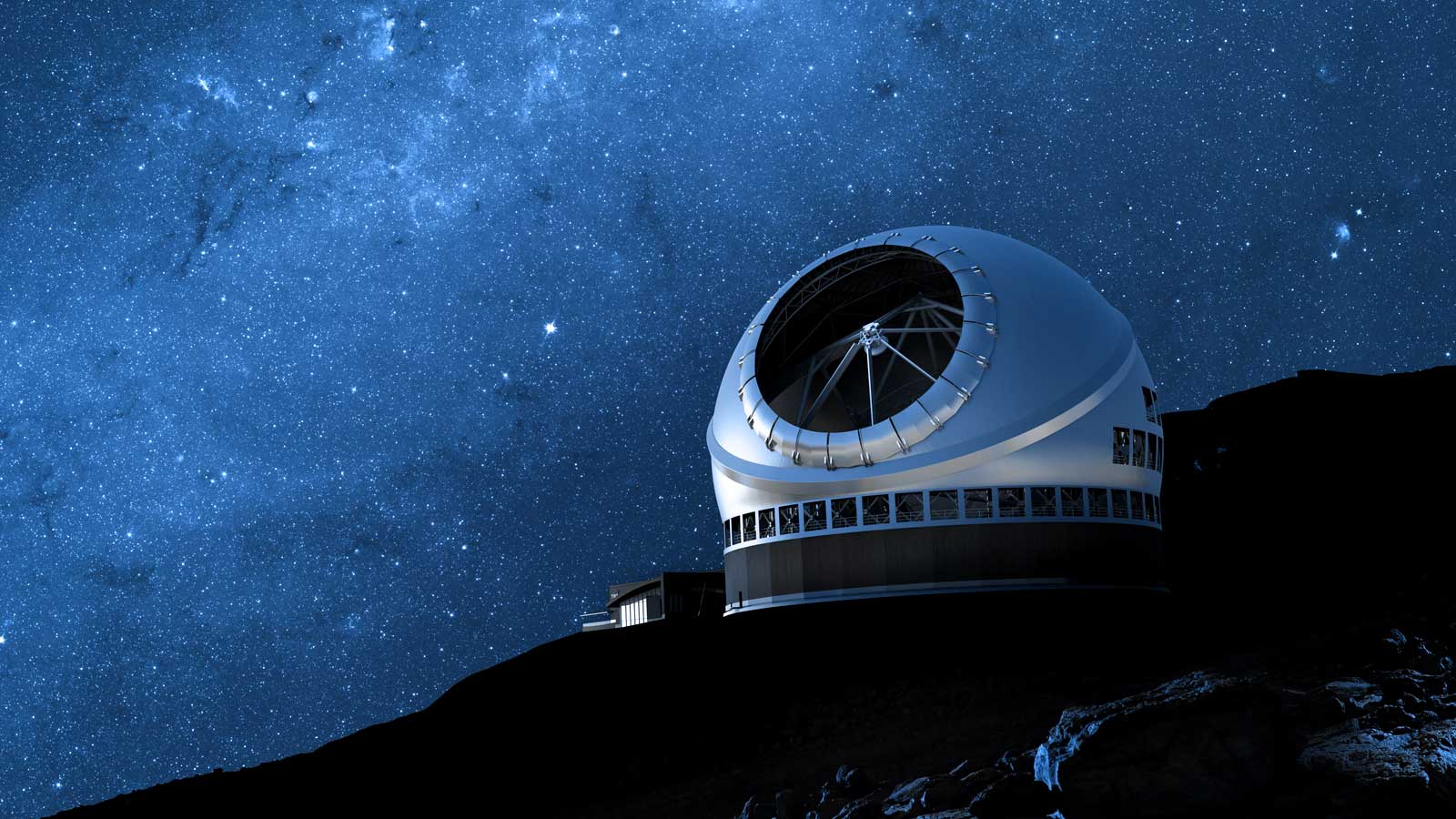
View of the TMT Adaptive Optics and telescope optics Alignment and Phasing Systems and the MODHIS Front End Instrument. The blue box structure is the Adaptive Optics System enclosure. The beam is steered into the system by the tertiary mirror (out view off the lower right) through the circular entrance on the white Science Calibration Unit. The Adaptive Optics System corrects for the distorting effects of the Earth’s atmosphere and delivers a diffraction limited beam to the instruments mounted to it. On top of the Adaptive Optics enclosure is the hexagonal shaped MODHIS Front End Instrument where light from exoplanets, stars and any other being studied is fed into optical fibers. The Alignment and Phasing System (APS) is the charcoal structure alongside the Adaptive Optics System. APS will measure the position and shape of all of optical elements in the telescope, the secondary and tertiary mirrors and all 492 segments in the primary mirror, and generate the corrections needed to be applied by the Telescope Control System to perfectly align all of the optics. In this view, the telescope tube is oriented straight up toward the zenith
Rendering of the completed Thirty Meter Telescope after sunset.
Saeko Hayashi (TMT/NAOJ) and Takashi Nakamoto (TMT/NAOJ) described the design of the M1 segment, its support structure, and associated control systems.
TMT staff gave introductory talks about TMT sciences, AO and science instrument capabilities, the connection between science cases and instrument requirements and the status in Hawaiʻi.
The overlapping observing coverage of the US-ELTP provides US astronomers with unfettered all-sky access from the Giant Magellan Telescope in the Southern Hemisphere and the Thirty Meter Telescope in the Northern Hemisphere. The timezone separation between the sites will increase the system’s capabilities for time-domain astrophysics.
TMT Project Manager Fengchuan Liu and Education, Outreach, and Broader Impacts Manager Yuko Kakazu gave presentations at the International Astronomical Union Asia-Pacific Regional Meeting (APRIM 2023) held from 7–11 August, in Koriyama City, Fukushima Prefecture, Japan.
U.S. Representative Judy Chu of California visited the TMT Lab in Monrovia in August 2023. TIO Executive Director Bob Kirshner and other project team members were on hand to talk about the project's development and showcase the work going on in the lab.
Sergio Salata, Astronomy Project Manager of Added Value Solutions (AVS) in Tenerife visits the TMT office. Sergio (far-right) joins a group of Caltech astronomy summer undergraduate research students, led by Prof. Matthew Graham (center), Project Scientist for the Zwicky Transient Factory, and visits the TMT lab. in California on 20 July 2023.
TMT edge sensors will align and stabilize the relative out-of-plane degrees of freedom (piston, tip, and tilt) of each 492 hexagonal mirror segment that forms the 30-meter TMT primary mirror.
The sensor dust boots are designed to keep the sensors clean and dry. Functionality of the sensors dust boots is verified on the segments mounted on the Multi Segment Integration & Test facility at TMT lab.
Sr. Optical Engineer & Group Leader of the M1 Optics at ITOFF S. Sriram (from left) along with optics team members Chetan C (Sr. Optics Technician), T. Nataraj (Sr. Optics Technician), Sanjeev Jha (Optical Engineer), Pramod Panchal (Optical Engineer), Remya B S (Sr. Optics Technical Assistant), Devika Divakar (Scientific Associate), Alikhan Basheer (Optical Engineer).